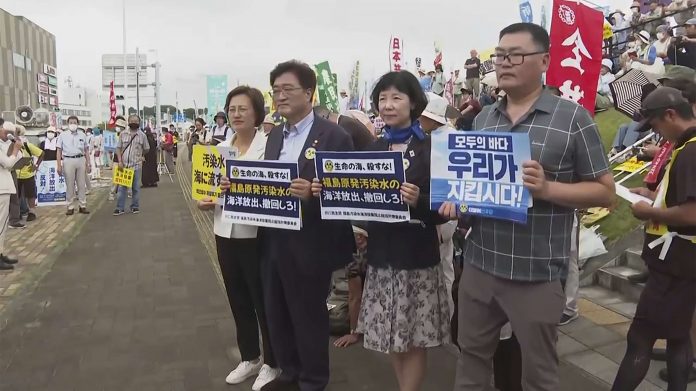
(AP) — At a small section of the Fukushima Daiichi nuclear plant’s central control room in northeastern Japan, the treated water transfer switch is on. A graph on a computer monitor nearby shows a steady decrease of water levels as treated radioactive wastewater is diluted and released into the Pacific Ocean.
In the coastal area of the plant, two seawater pumps are in action, gushing torrents of seawater through sky blue pipes into the big header where the treated water, which comes down through a much thinner black pipe from the hilltop tanks, gets diluted by hundreds of times before the release.
The sound of the treated and diluted radioactive water flowing into an underground secondary pool was heard from beneath the ground during Sunday’s first plant tour for media, including The Associated Press, since the controversial release began.
“The best way to eliminate the contaminated water is to remove the melted fuel debris,” said Tokyo Electric Power Company Holdings spokesperson Kenichi Takahara, who escorted Sunday’s media tour for the foreign press.
But Takahara said the scarcity of information from inside the reactors makes planning and development of the necessary robotic technology and a facility for the melted fuel removal extremely difficult.
“Removal of the melted fuel debris is not like we can just take it out and be finished,” he said.
The projected decades-long release of treated water has been strongly opposed by fishing groups and criticized by neighboring countries. China immediately banned imports of seafood from Japan in response. In Seoul, thousands of South Koreans rallied over the weekend to condemn the release, demanding Japan to keep it in tanks.
For the wrecked Fukushima Daiichi, managing the ever-growing volume of radioactive wastewater held in more than 1,000 tanks has been a safety risk and a burden since the meltdown in March 2011. Its release marks a milestone for the decommissioning of the plant, which is expected to take decades.
They say the water is treated and diluted to levels that are safer than international standards, and so far, test results by TEPCO and government agencies found radioactivity in seawater and fish samples taken after the release were below detectable levels.
The Japanese government and TEPCO say releasing the water is an unavoidable step in the decommissioning of the plant.
The March 2011 earthquake and tsunami destroyed the plant’s cooling systems, causing three reactors to melt. Highly contaminated cooling water applied to the damaged reactors has leaked continuously to building basements and mixed with groundwater. The water is collected and partly recycled as cooling water after treatment, with the rest stored in around 1,000 tanks, which are already filled to 98% of their 1.37 million-ton capacity.
The release, which started at the daily pace of 460 tons, is moving slowly. TEPCO says it plans to release 31,200 tons of treated water by the end of March 2024, which would empty only 10 tanks out of 1,000 because of the continued production of the radioactive water.
The pace will later pick up and about 1/3 of the tanks will be removed over the next 10 years, freeing up space for the plant’s decommissioning, said TEPCO executive Junichi Matsumoto, who is in charge of the treated water release. He says the water would be released gradually over the span of 30 years. But as long as the melted fuel stays in the reactors, it requires cooling water under the current prospect.
About 880 tons of radioactive melted nuclear fuel remain inside the reactors. Robotic probes have provided some information but the status of the melted debris remains largely unknown, and the amount could be even larger, says Takahara, the TEPCO spokesman.



















